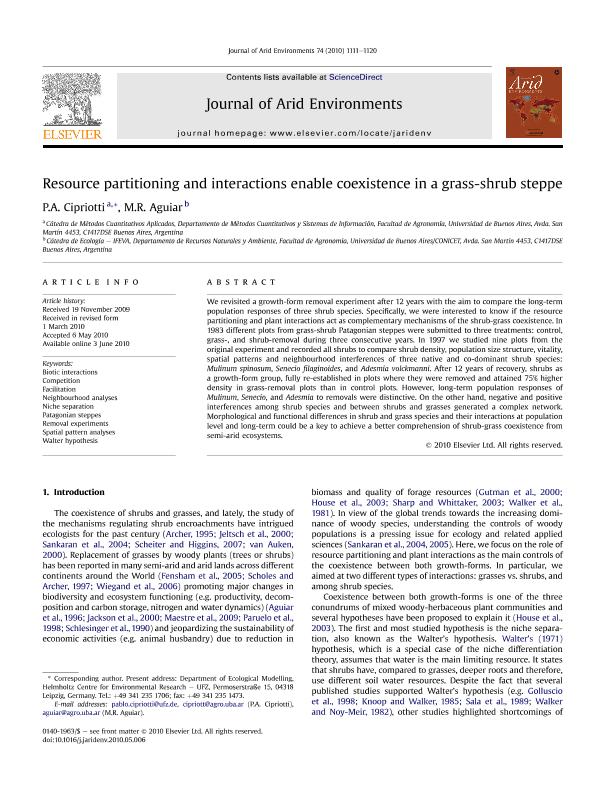Mostrar el registro sencillo del ítem
dc.contributor.author
Cipriotti, Pablo Ariel

dc.contributor.author
Aguiar, Martin Roberto

dc.date.available
2019-03-11T20:24:32Z
dc.date.issued
2010-10
dc.identifier.citation
Cipriotti, Pablo Ariel; Aguiar, Martin Roberto; Resource partitioning and interactions enable coexistence in a grass-shrub steppe; Academic Press Ltd - Elsevier Science Ltd; Journal of Arid Environments; 74; 10; 10-2010; 1111-1120
dc.identifier.issn
0140-1963
dc.identifier.uri
http://hdl.handle.net/11336/71400
dc.description.abstract
We revisited a growth-form removal experiment after 12 years with the aim to compare the long-term population responses of three shrub species. Specifically, we were interested to know if the resource partitioning and plant interactions act as complementary mechanisms of the shrub-grass coexistence. In 1983 different plots from grass-shrub Patagonian steppes were submitted to three treatments: control, grass-, and shrub-removal during three consecutive years. In 1997 we studied nine plots from the original experiment and recorded all shrubs to compare shrub density, population size structure, vitality, spatial patterns and neighbourhood interferences of three native and co-dominant shrub species: Mulinum spinosum, Senecio filaginoides, and Adesmia volckmanni. After 12 years of recovery, shrubs as a growth-form group, fully re-established in plots where they were removed and attained 75% higher density in grass-removal plots than in control plots. However, long-term population responses of Mulinum, Senecio, and Adesmia to removals were distinctive. On the other hand, negative and positive interferences among shrub species and between shrubs and grasses generated a complex network. Morphological and functional differences in shrub and grass species and their interactions at population level and long-term could be a key to achieve a better comprehension of shrub-grass coexistence from semi-arid ecosystems. © 2010 Elsevier Ltd.
dc.format
application/pdf
dc.language.iso
eng
dc.publisher
Academic Press Ltd - Elsevier Science Ltd

dc.rights
info:eu-repo/semantics/openAccess
dc.rights.uri
https://creativecommons.org/licenses/by-nc-sa/2.5/ar/
dc.subject
Biotic Interactions
dc.subject
Competition
dc.subject
Facilitation
dc.subject
Neighbourhood Analyses
dc.subject
Niche Separation
dc.subject
Patagonian Steppes
dc.subject
Removal Experiments
dc.subject
Spatial Pattern Analyses
dc.subject
Walter Hypothesis
dc.subject.classification
Agricultura

dc.subject.classification
Agricultura, Silvicultura y Pesca

dc.subject.classification
CIENCIAS AGRÍCOLAS

dc.title
Resource partitioning and interactions enable coexistence in a grass-shrub steppe
dc.type
info:eu-repo/semantics/article
dc.type
info:ar-repo/semantics/artículo
dc.type
info:eu-repo/semantics/publishedVersion
dc.date.updated
2019-03-08T20:27:43Z
dc.journal.volume
74
dc.journal.number
10
dc.journal.pagination
1111-1120
dc.journal.pais
Estados Unidos

dc.journal.ciudad
Nueva York
dc.description.fil
Fil: Cipriotti, Pablo Ariel. Consejo Nacional de Investigaciones Científicas y Técnicas; Argentina. Universidad de Buenos Aires. Facultad de Agronomía; Argentina
dc.description.fil
Fil: Aguiar, Martin Roberto. Consejo Nacional de Investigaciones Científicas y Técnicas. Oficina de Coordinación Administrativa Parque Centenario. Instituto de Investigaciones Fisiológicas y Ecológicas Vinculadas a la Agricultura. Universidad de Buenos Aires. Facultad de Agronomía; Argentina
dc.journal.title
Journal of Arid Environments

dc.relation.alternativeid
info:eu-repo/semantics/altIdentifier/url/https://www.sciencedirect.com/science/article/pii/S0140196310001321
dc.relation.alternativeid
info:eu-repo/semantics/altIdentifier/doi/https://doi.org/10.1016/j.jaridenv.2010.05.006
Archivos asociados
